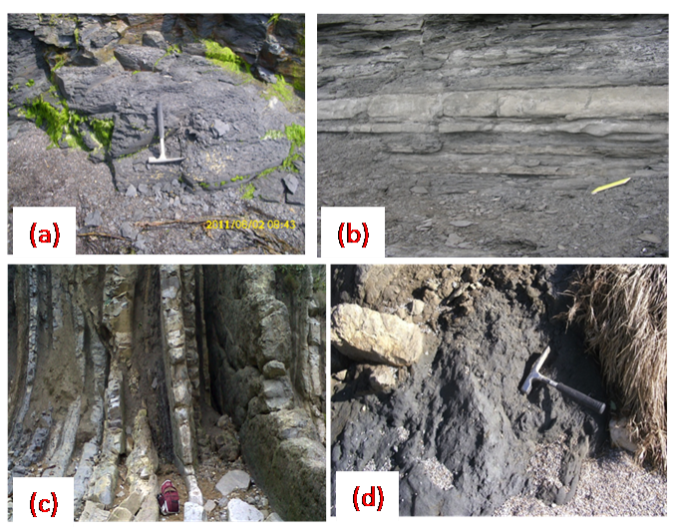-
Paper Information
- Next Paper
- Previous Paper
- Paper Submission
-
Journal Information
- About This Journal
- Editorial Board
- Current Issue
- Archive
- Author Guidelines
- Contact Us
Geosciences
p-ISSN: 2163-1697 e-ISSN: 2163-1719
2012; 2(6): 164-169
doi: 10.5923/j.geo.20120206.03
Evaluation of Hydrocarbon Generation Potential of the Mesozoic Organic-Rich Rocks Using TOC Content and Rock-Eval Pyrolysis Techniques
Waheed Gbenga Akande
Department of Geology, Federal University of Technology, Minna, +234, Nigeria
Correspondence to: Waheed Gbenga Akande , Department of Geology, Federal University of Technology, Minna, +234, Nigeria.
| Email: |  |
Copyright © 2012 Scientific & Academic Publishing. All Rights Reserved.
This paper investigates the hydrocarbon generation potential of the Mesozoic organic-rich rocks of Dorset area in the Wessex Basin. The objectives of this study are to sample the organic-rich rock outcrops from the Dorset area of southern England and to assess the quality of these organic-rich rocks by organic geochemical analyses. A total of eight outcrop samples of organic-rich rocks collected from six Mesozoic stratigraphic intervals along the coastline of Dorset were analyzed using total organic carbon (TOC) content analysis and Rock-Eval Pyrolysis technique. The analytical results of the studied outcrop samples revealed that they have high total organic carbon (TOC) contents, suggesting that there exist conditions in the Mesozoic that favoured organic matter production and preservation. There is a variation in the kerogen types and this may be attributed to the relative stratigraphic positions of the outcrops within the basin. The Rock-Eval results indicated that the Blue Lias, the Kimmeridge Clay Formation, the Oxford Clay, and the Nothe Clay contain predominantly Type II kerogen with a capacity to generate oil and gas; the Gault Clay contains mainly Type III kerogen and is gas-prone with poor to fair or lean generative potential; and the Purbeck Black Shale comprises Type I kerogen and is oil-prone with high organic matter content and hence has excellent generative potential.
Keywords: Generation Potential, Mesozoic, Total Organic Carbon, Rock-Eval, Kerogen Type
Cite this paper: Waheed Gbenga Akande , "Evaluation of Hydrocarbon Generation Potential of the Mesozoic Organic-Rich Rocks Using TOC Content and Rock-Eval Pyrolysis Techniques", Geosciences, Vol. 2 No. 6, 2012, pp. 164-169. doi: 10.5923/j.geo.20120206.03.
Article Outline
1. Introduction
- Source rock evaluation studies entail assessing the hydrocarbon generating potential of sediments by looking at the sediment’s capacity for hydrocarbon generation, type of organic matter (kerogen) present and what hydrocarbons might be expected after generation, and the sediment’s thermal maturity and how it has influenced generation[1]. The commonly used analytical methods for these studies during hydrocarbon exploration are the total organic carbon (TOC) content analysis, Rock-Eval pyrolysis, and vitrinite reflectance analysis. Some of the possible drawbacks in using these analytical techniques can be overcome by integrating the results of various analyses, and keeping in mind the possible errors that might arise from each method. Though these geochemical methods as well as petrographic technique and the like have been employed to study some of the Mesozoic organic-rich rocks considered in this paper, the Purbeck Black Shale, the Nothe Clay and the Gault Clay Formations have been incredibly neglected for decades, and therefore have scanty data in the literature.
2. Aim and Objectives
- This study investigates and characterises the hydrocarbon generation potential of the entire Mesozoic organic-rich rocks of Dorset area in the Wessex Basin, southern England, using the TOC content analysis and Rock-Eval Pyrolysis technique. The objectives achieved are:(a) sampling the organic-rich rock outcrops from the Dorset area of southern England.(b) assessing the quality of these organic-rich rocks by organic geochemical analyses–TOC content and Rock-Eval pyrolysis techniques.
3. Literature Review
- Oil exploration in the Wessex Basin starts from the early twentieth century. The successes recorded in the second half of the century (1950s and 1960s) significantly triggered the interests of oil industries and geologists in geological mapping of structures and subsequently geochemical studies of oils and potential petroleum source rocks in the basin[2]. Of these potential source rocks, Kimmeridge Clay Formation was mostly intensively studied[3]. Williams[4] examined the organic maturity and source rock potential of the onshore Kimmeridge Clay Formation of southern and eastern England, and evaluated the possibilities for onshore oil generation from the Formation. His geochemical results showed that onshore basin margin sediments contain rich, potential source horizons with mainly Type I or Type II oil-prone kerogen, but are immature. Similarly, Scotchman[5] investigated the Kerogen facies and maturity of the Kimmeridge Clay Formation in southern and eastern England. His result demonstrated that kerogen facies appeared to be strongly controlled by the sedimentation rate and the paleogeography of the basin such that type III kerogens predominate in the basin margin areas; type II kerogens are restricted to the basin centres whereas mixed Type II-Type III kerogens are prevalent over the intermediate shelf areas.The classic petrographic and geochemical studies of Lallier-Vergès et al.[6] showed that Kimmeridgian shales of Dorset, UK have a very wide range of TOC and the hydrogen index (HI) values. They invoked deposition of organic sediments of the Kimmeridge Clay Formation under oxygenation water column with a redox boundary that fluctuated above and below the water-sediment interface, solely due to variations in the organic influx or productivity as the explanation. Ebukanson and Kinghorn[7] investigated the kerogen types and their hydrocarbon-generating potentials in three main mudrock units – the Lower Lias, the Oxford Clay and the Kimmeridge Clay, in the Jurassic of southern England. Their results revealed that the identified kerogen types are capable of generating both oil and gas. In addition, Buchanan[2] has also indicated that these Jurassic formations have sufficient organic matter contents to be source rocks for hydrocarbons.
4. Materials and Methods
- This study involved outcrops sampling (Figure 1) of the organic-rich rocks along the coastline of Dorset, southern England and total of eight samples were collected. Some of the photos of the outcrops are shown in Figure 2. The samples names and location details are summarized in Table1. The outcrop samples were taken to the Organic Geochemistry Laboratory, Imperial College London, where they were oven-dried overnight at 110℃, and pulverized with the aid of pestle and mortar. The crushed rock samples were analyzed geochemically by TOC contents and Rock-Eval pyrolysis techniques.
|
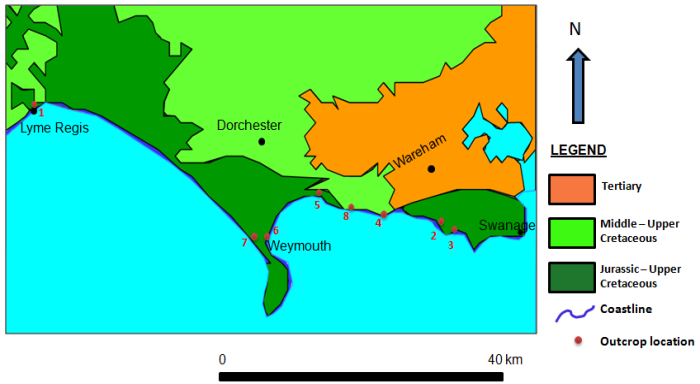 | Figure 1. The map of the study area with outcrop locations[8] |
4.1. Total Organic Carbon (TOC) Contents and Rock-Eval Analyses
- The pulverised rock samples submitted to GH Geochemical Laboratory, University of Liverpool, were analysed for TOC contents, HI, the oxygen index (OI) and Tmax (temperature of maximum kerogen pyrolysate yield), using Rock-Eval II instrument.The oven was initially kept isothermally at 300℃ for 3 mins during which time the free hydrocarbons are volatilized and the S1 peak is measured by the Flame Ionization Detector (FID). Pyrolysis of organic matter was later performed at 300 – 600℃ with a temperature rise of 25℃/min. This is the phase of volatilization of the higher carbon number hydrocarbons compounds (>C40) as well as the cracking of non-volatile organic matter. The hydrocarbons released from this thermal cracking are measured as the S2 peak (by FID). The temperature at which S2 reaches its maximum depends on the nature and thermal maturity of the kerogen and this is measured as Tmax. The CO2 produced from kerogen cracking is trapped in the 300 - 390℃ range. The trap is heated, and CO2 is released and detected on a Thermal Conductivity Detector (TCD) during the cooling of the Pyrolysis oven (S3 peak). The HI was determined as the yield of reduced products of pyrolysis (S2) relative to the TOC (mg HC/g TOC) and OI is the yield of the oxygen and bound organic carbon (S3).
5. Results and Discussions
- The results of the TOC contents and Rock-Eval data for the studied outcrop samples are presented in Table 2. In a bid to display the distributions of the TOC values of the samples, TOC versus Outcrop/Formation location number (as used in Table 1) plot is generated and presented in Figure 3.In order to characterize the organic matter type (kerogen type) of the samples, the modified Van Krevelen diagram (HI versus OI) is displayed in Figure 4. For the evaluation of the generation potential, graphs of (S1 + S2) against TOC[9] and the Rock-Eval HI versus TOC[10] were plotted and shown in Figures 5 and 6 respectively.
|
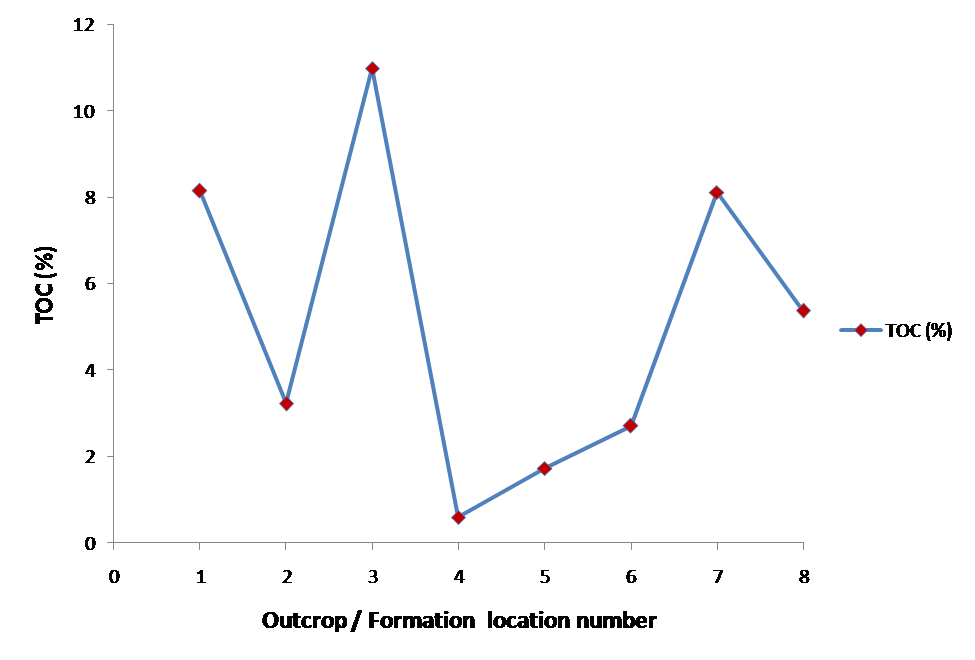 | Figure 3. Trend of TOC values in the studied samples[Numbers 1 – 8 as used in Table 1] |
5.1. Organic Matter (Kerogen) Type
- The organic matter type is an important parameter in evaluating source rock potential and has important influence on the nature of the hydrocarbon products[11],[12] and[13]. Peters[14] proposed that, for mature source rock, HI for gas-prone organic matter is less than 150, gas-oil-prone organic matter is ranged between 150 and 300, whereas the oil-prone organic matter is more than 300 HI. Thus, it is very important to determine the kerogen types of the source rocks as they have a first-order control on the hydrocarbon products after maturation.The results from this study showed that the HI values are greater than 300 (Table 2) for the majority of the samples. Thus, they are oil-prone. However, there are few exceptions. The Gault Clay sample has HI value of 66 mg/ g, meaning that it is an ideal potential gas generator. The Nothe Clay and one of the Oxford Clay samples have the HI values 185 mg/ g and 229 mg/ g respectively indicating that they are gas-oil-prone. Tissot and Welte[12] proposed a genetic potential (SP = S1 + S2) for the classification of source rocks. According to their classification scheme, rocks having SP of less than 2 mg HC/ g rock correspond to gas-prone rocks or non-generative ones, rocks with SP between 2 and 6 mg HC/ g rock are moderate source rocks, and those with SP greater than 6 mg HC/ g rock are good source rocks. Based on the above criteria, the Gault Clay sample with a SP of 0.49 is either a gas-prone rock or non-generative rock. They added further that those rocks with exceptionally high SP values in order of 100 or 200 mg HC/ g rock may provide either an excellent source rock, if the burial depth is sufficient, or an oil shale, if the burial depth is shallow. Thus, the Kimmeridge Clay Formation and the Purbeck Black Shale with fairly high genetic potential may constitute excellent source rocks at sufficient depths.The modified Van Krevelen diagram (HI versus OI) (Figure 4) for the studied samples shows that the rocks consist of Type II kerogens, which are capable of generating both oil and gas at suitable temperature in depth. The only exceptions are the Gault Clay and Purbeck Black Shale samples which have Type III and type I kerogens respectively. These results confirmed the findings of the earlier workers on the potential source rocks of southern England (e.g.,[7] &[5]) that there is a variation in kerogen types which may be related to the relative stratigraphic positions of the outcrops within the basin.
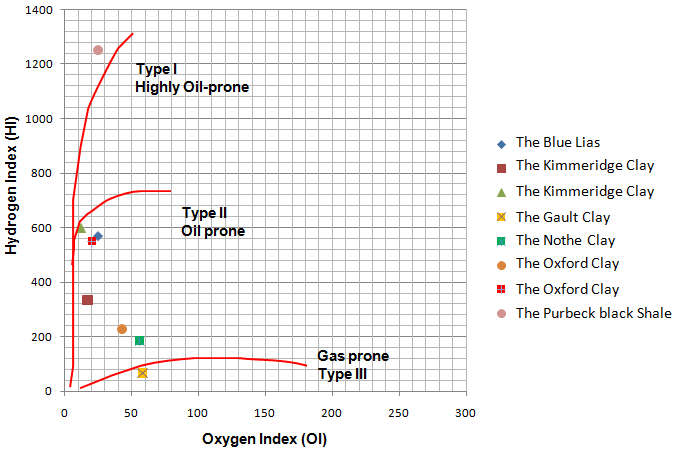 | Figure 4. Modified Van Krevelen diagram showing the organic matter types of the studied samples |
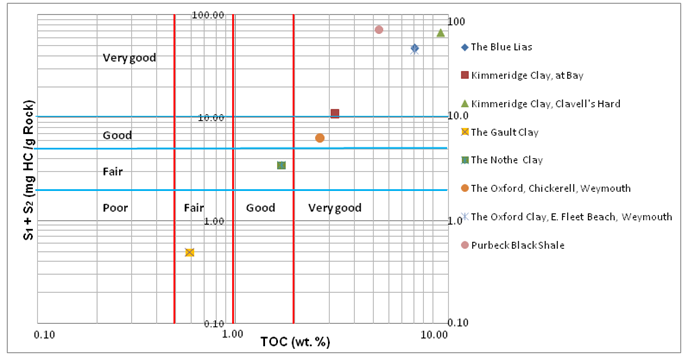 | Figure 5. Generation potential for the studied samples[9] |
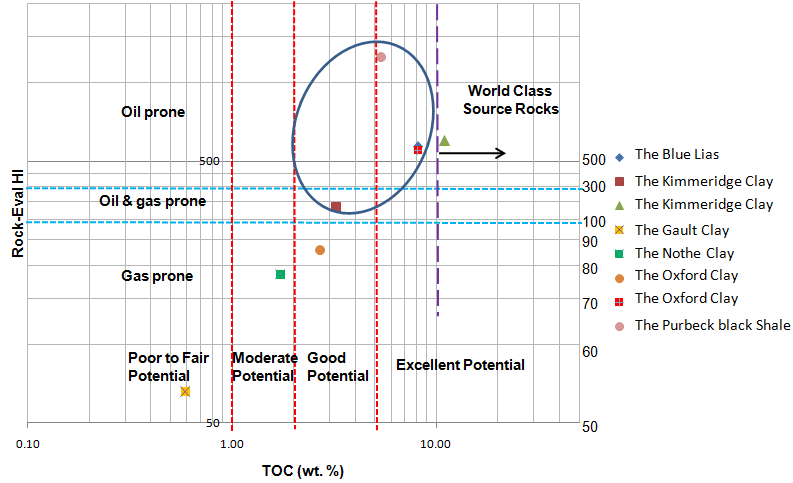 | Figure 6. Generative potential of potential source rocks of Dorset. The blue outline (ellipse) is the field of typical oil-prone source rocks[10] |
5.2. Source Rock Richness and Generation Potential
- The organic matter richness of source rocks is determined usually using the total organic carbon content, which is the total amount of organic material (kerogen) present in the rock, expressed as a percentage by weight (TOC wt.%). By and large, the higher the TOC, the better the chance and potential for hydrocarbon generation. According to Peters[14], the TOC values between 0.5 and 1.0% indicate a fair source-rock generative potential, TOC values varying from 1.0 to 2.0% reflect a good generative potential, TOC values between 2.0 and 4.0% refer to a very good generative potential, and rocks with TOC greater than 4.0% are considered to have excellent generative potential. In line with this criterion, the TOC results of rock samples in this study show that the Gault Clay outcrop sample (Table 2) has a fair generative potential, the Nothe Clay sample has moderate generative potential while the other samples have good to excellent generative potential. This is demonstrated in the plot of the Rock–Eval HI versus TOC (Figure 6). The good to excellent generation potential of the Blue Lias, the Kimmeridge Clay and the Oxford Clay and the Purbeck Black Shale samples in particular is supported by the presence of type I & II kerogens (Figure 4). It is also worth pointing out that the Blue Lias, the Kimmeridge Clay, the Oxford Clay and the Purbeck Black Shale samples fall within the field of typical oil-prone source rocks[10] as shown in Figure 6. Finally, the Kimmeridge Clay sample falls in the field typical of World Class source rocks, further confirming the widely held views on the Kimmeridge Clay Formation.
6. Conclusions
- Results of TOC and Rock-Eval analyses of potential hydrocarbon source rocks in the Mesozoic stratigraphic intervals of the Wessex Basin show that: (i) the prevailing paleogeographic and climatic conditions during the Mesozoic favoured organic matter production and/or preservation, which led to high organic matter contents in various stratigraphic intervals of the Mesozoic in the Wessex Basin, southern England;(ii) the Blue Lias, the Kimmeridge Clay Formation, the Oxford Clay, and the Nothe Clay contain predominantly Type II kerogen and are both oil- and gas-prone, and the organic matter content intermediate from good to very good and so does the generative potential from moderate to excellent; (iii) the Gault Clay contains mainly Type III kerogen and is gas prone, but the organic carbon content is generally only poor to fair so generative potential is lean; and(iv) the Purbeck Black Shale comprises Type I kerogen and is oil-prone with high organic matter content, and therefore has excellent generative potential.
7. Recommendations
- The studied outcrop samples have right kerogen types and the potential to generate hydrocarbons at a suitable temperature in depth. The variation in the kerogen types may be attributed to the relative stratigraphic positions of the outcrops within the basin. The results of this study also unlocked the petroleum generation potential of the least studied organic-rich rocks in the basin - the Nothe Clay, Purbeck Black Shale, and the Gault Clay – and revealed that they have some potential for hydrocarbon generation except for the Gault Clay with poor to fair or lean generative potential. Hence, it is recommended that besides the Kimmeridge Clay Formation, the Blue Lias and the Oxford Clay Formation, the Purbeck Black Shale and the Nothe Clay should be considered for hydrocarbon exploration in the study area.
 Abstract
Abstract Reference
Reference Full-Text PDF
Full-Text PDF Full-Text HTML
Full-Text HTML
